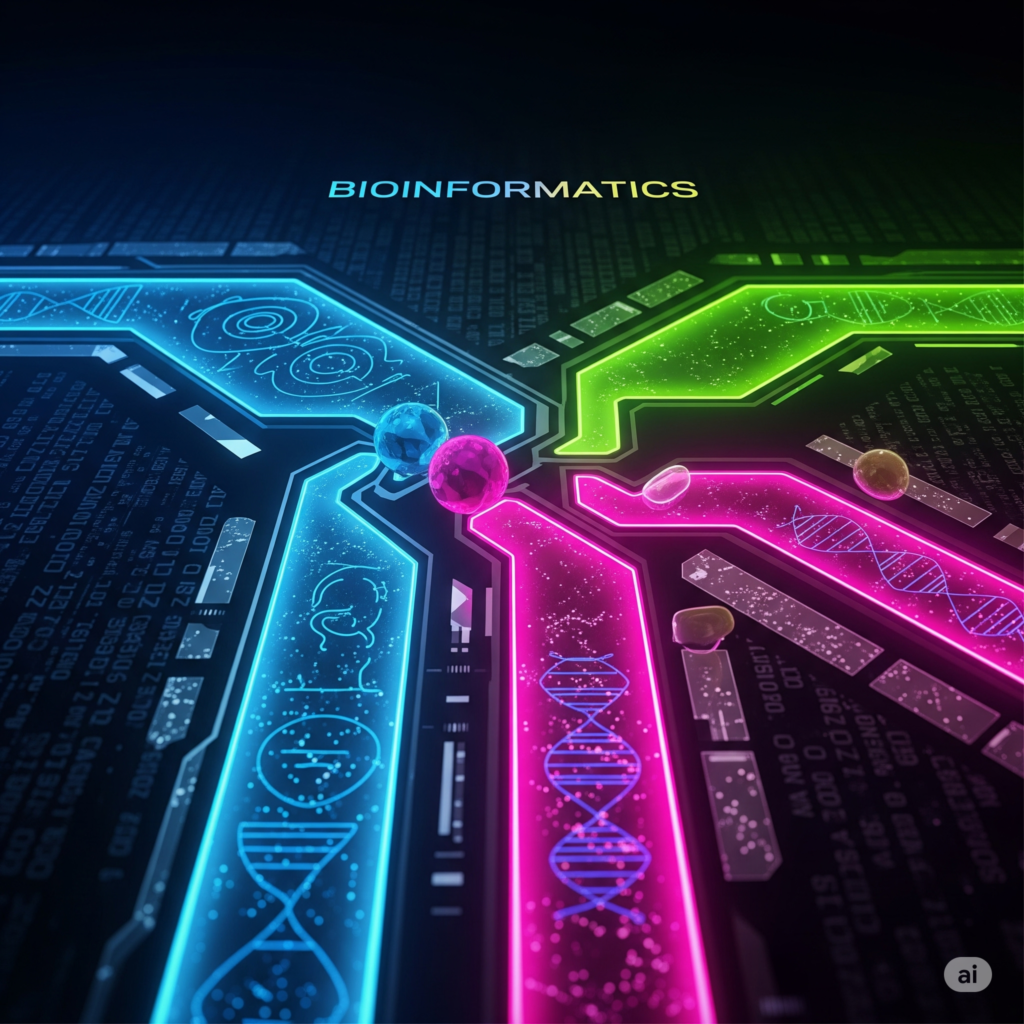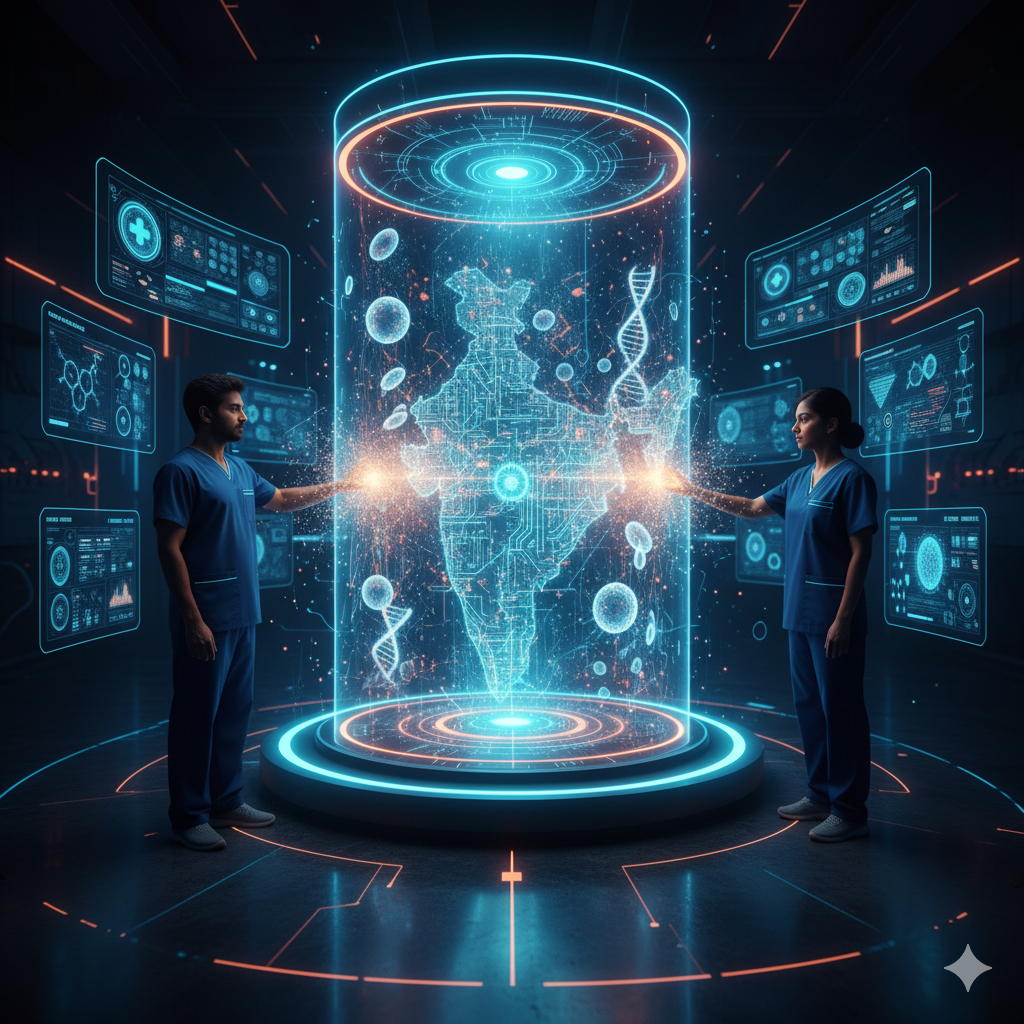Introduction
In the age of information and genomics, biology has become a data-rich science. With the completion of the Human Genome Project and advancements in high-throughput technologies, biologists are now confronted with vast amounts of data that need to be processed, analyzed, and interpreted. The field that enables this transformation of biological data into meaningful knowledge is known as bioinformatics. This interdisciplinary science combines biology, computer science, mathematics, and statistics to manage, analyze, and interpret biological data. It plays a critical role in areas such as genomics, proteomics, evolutionary biology, drug discovery, and personalized medicine.
Definition and Scope of Bioinformatics
Bioinformatics can be defined as the application of computational techniques to store, retrieve, analyze, and interpret biological data. It is primarily concerned with the development and application of tools and algorithms for understanding biological processes through data analysis. These processes include the study of DNA, RNA, proteins, and other biomolecules.
The scope of bioinformatics extends across multiple domains:
- Genomics (study of genomes)
- Proteomics (study of proteins and their functions)
- Transcriptomics (study of RNA transcripts)
- Metabolomics (study of metabolic pathways and molecules)
- Systems biology (study of complex biological interactions)
This wide scope allows bioinformatics to be integral in academic research, pharmaceutical industries, agricultural sciences, environmental studies, and clinical applications.
Historical Background
The origins of bioinformatics date back to the 1960s when protein sequences were first analyzed using computers. However, the field gained momentum in the 1990s with the Human Genome Project, a massive initiative aimed at sequencing the entire human genome. As the amount of genetic data grew exponentially, traditional methods of analysis became insufficient, paving the way for computational biology.
The development of algorithms like BLAST (Basic Local Alignment Search Tool), databases like GenBank, and genome browsers marked the beginning of modern bioinformatics. Today, bioinformatics continues to evolve rapidly with innovations in artificial intelligence, cloud computing, and machine learning being integrated into the field.
Key Components of Bioinformatics
1. Biological Databases
Bioinformatics relies heavily on the storage and management of biological data. Numerous biological databases have been created to catalog this information:
- GenBank: A nucleotide sequence database maintained by the NCBI (National Center for Biotechnology Information).
- UniProt: A protein sequence and functional information database.
- PDB (Protein Data Bank): Contains 3D structural data of proteins and nucleic acids.
- Ensembl: A genome browser providing annotated genomes of various species.
These databases are publicly accessible and serve as essential resources for research and discovery.
2. Algorithms and Tools
Bioinformatics uses a variety of algorithms to analyze biological sequences:
- Sequence alignment algorithms (e.g., BLAST, ClustalW) compare DNA, RNA, or protein sequences to identify similarities and evolutionary relationships.
- Gene prediction tools identify regions of DNA that encode genes.
- Protein structure prediction algorithms forecast 3D shapes based on amino acid sequences.
- Phylogenetic analysis tools reconstruct evolutionary histories of organisms.
Machine learning and AI are increasingly being applied to develop more accurate prediction models.
3. Data Analysis and Visualization
Analyzing vast datasets is a core task in bioinformatics. Tools such as R, Python (with BioPython), MATLAB, and specialized software like Cytoscape, MEGA, and Geneious are widely used. Visualization is critical for interpreting results—genome browsers, heat maps, and protein structure viewers help researchers see patterns and draw conclusions.
Applications of Bioinformatics
1. Genomics and Genome Annotation
Bioinformatics plays a pivotal role in sequencing and annotating genomes. It helps identify genes, regulatory elements, and mutations that may lead to disease. Comparative genomics allows scientists to study evolutionary changes between species and understand genetic diversity.
2. Proteomics
Through bioinformatics, researchers analyze large-scale protein data to understand protein function, interaction networks, and expression patterns. This is vital for identifying disease biomarkers and drug targets.
3. Drug Discovery and Development
In pharmaceutical research, bioinformatics aids in in silico drug design, virtual screening of drug libraries, and predicting drug efficacy. Molecular docking simulations show how drugs interact with target proteins. This shortens the drug development timeline and reduces costs.
4. Personalized Medicine
By analyzing a person’s genetic makeup, bioinformatics enables tailored medical treatments based on individual variations. This includes predicting drug responses and genetic predispositions to diseases, thereby improving treatment outcomes.
5. Evolutionary Biology
Using sequence comparison and phylogenetic analysis, bioinformatics helps reconstruct the evolutionary history of organisms. It provides insights into how genes and species have evolved over time.
6. Agricultural Biotechnology
Bioinformatics is used to improve crop yield, disease resistance, and stress tolerance by identifying beneficial genetic traits. Genome editing technologies like CRISPR are guided by bioinformatics analyses.
7. Metagenomics and Microbial Ecology
Bioinformatics helps analyze DNA from environmental samples, revealing microbial communities in oceans, soils, and the human gut. This uncovers roles of microbes in ecosystems and human health.
Emerging Trends in Bioinformatics
Artificial Intelligence and Machine Learning
AI and ML are being used to develop predictive models for disease, drug interactions, and protein structures. These models learn from data and improve over time, enhancing the accuracy of predictions.
Cloud Computing and Big Data
The massive size of genomic data necessitates high computational power. Cloud-based platforms such as Google Cloud and Amazon Web Services are used for storing, sharing, and analyzing large datasets.
Integrative Omics
Integrative omics combines data from genomics, proteomics, metabolomics, and transcriptomics to offer a comprehensive understanding of biological systems.
CRISPR and Gene Editing
Bioinformatics supports CRISPR by identifying precise target sites in the genome, ensuring specificity, and minimizing off-target effects.
Challenges in Bioinformatics
1. Data Overload
The exponential growth of biological data presents challenges in storage, management, and interpretation. Efficient algorithms and high-capacity infrastructure are required.
2. Data Standardization
Lack of standardized formats and protocols across databases and tools leads to inconsistencies and interoperability issues.
3. Interpretation and Validation
Understanding the biological meaning of computational predictions is complex and often requires experimental validation.
4. Ethical and Privacy Concerns
Genomic data is highly personal. Ensuring privacy, data security, and ethical use is essential, especially in clinical settings.

Bioinformatics in India
India is emerging as a hub for bioinformatics research. Institutions like the Institute of Genomics and Integrative Biology (IGIB), Indian Institute of Science (IISc), and CSIR labs are at the forefront of genomics and data analysis. The Indian Genome Variation Consortium and government initiatives such as the National Bioinformatics Mission aim to harness bioinformatics for healthcare and agriculture.
Future of Bioinformatics
The future of bioinformatics lies in greater integration with biotechnology, artificial intelligence, and personalized healthcare. As technologies become more affordable, genomic testing and precision medicine will become routine. AI-driven analysis will reduce the need for manual interpretation, making bioinformatics more accessible.
Furthermore, international collaborations and open science will foster innovation and data sharing. With advancements in quantum computing, real-time analysis of entire genomes may soon be possible, revolutionizing how we understand and treat diseases.
Conclusion
Bioinformatics is at the heart of modern biology. By merging computer science with life sciences, it provides the tools to decode the complexities of living organisms. From understanding the genetic basis of diseases to designing new drugs, bioinformatics is transforming medicine, agriculture, and environmental science.
As biological data continues to grow, the importance of bioinformatics will only increase. The future promises smarter, faster, and more personalized solutions to some of the greatest challenges in health and life sciences. For students, researchers, and professionals, bioinformatics represents a dynamic and impactful field with endless possibilities.
Summary Points
India’s Role: National initiatives and research institutions are advancing bioinformatics for healthcare and agriculture.
Definition: Bioinformatics is the use of computational tools to store, analyze, and interpret biological data.
Key Areas: Genomics, proteomics, drug discovery, personalized medicine, agriculture, and evolutionary studies.
Tools: Databases (GenBank, UniProt), software (BLAST, ClustalW), programming languages (Python, R), and visualization platforms.
Applications: Gene annotation, disease diagnostics, protein structure prediction, drug design, and microbial ecology.
Emerging Trends: AI, machine learning, cloud computing, CRISPR integration, and big data analytics.
Challenges: Data overload, standardization, ethical issues, and experimental validation.




